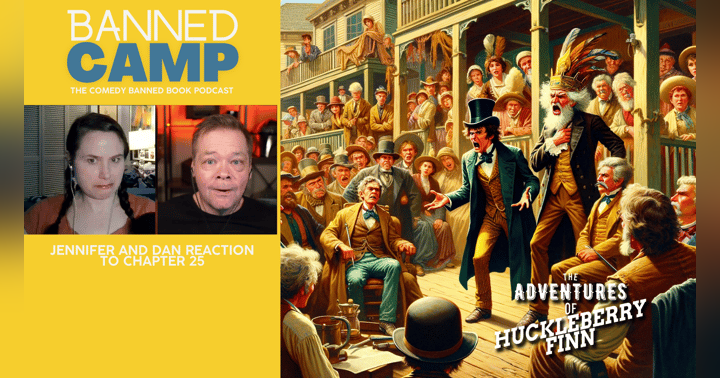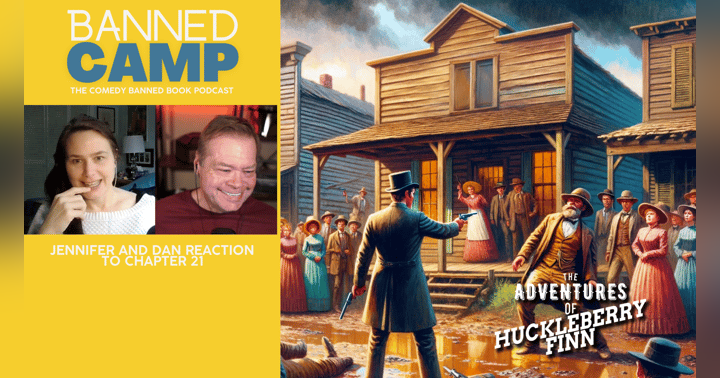Huck Finn's River Shenanigans: Chapter 19 Explored | Banned Camp

Welcome to the literary rabbit hole of "Banned Camp," where we, Jennifer and Dan, delve into the depths of banned literature, one chapter at a time. In our latest foray, we've tackled Chapter 19 of Mark Twain’s classic, “The Adventures of Huckleberry Finn.” This episode, which can be explored in full here, is not just a read-through; it's an expedition into understanding why such a pivotal book has faced the brunt of censorship.
Our podcast, a fusion of humor and critical analysis, challenges the norms of literary discussions. We don’t just read; we question, laugh, and sometimes marvel at the absurdity of the reasons behind book bans. Chapter 19 is a prime example of Twain's mastery in storytelling and character creation, which we dissect with our signature blend of wit and insight. In this chapter, Huck encounters two con artists who claim highborn status, leading to a series of events that are as thought-provoking as they are amusing.
At "Banned Camp," we're not just about chuckles and guffaws. We also dive into the darker, more serious aspects of literature. This chapter, for instance, sheds light on themes of deception, identity, and the societal norms of the era, all while floating down the Mississippi. Join us as we unravel the intricacies of Twain's work, and perhaps, understand a bit more about why this gem of American literature often finds itself in the crosshairs of censors.
What Is In Chapter 19 Of "The Adventures of Huckleberry Finn"?
In Chapter 19 of Mark Twain’s “The Adventures of Huckleberry Finn,” we find ourselves amidst a curious turn of events on Huck and Jim’s journey. As they navigate the complexities of life on the Mississippi, they encounter two characters who are as enigmatic as they are dubious. These two self-proclaimed nobles – one claiming to be the Duke of Bridgewater and the other the Dauphin, heir to the French throne – add a layer of whimsical deceit to the narrative.
This chapter is a beautiful tapestry of Twain's humor and his keen observation of human nature. Our protagonists, Huck and Jim, are now accompanied by these two con artists, leading to a series of adventures that are both humorous and revealing. The interactions between these characters are not just entertaining but are also a mirror to the societal norms and the concept of identity during Twain's time.
At Banned Camp, we do more than just recount these chapters. We dive into the nuances, the unspoken words, and the hidden meanings. To catch up on all the Banned Camp episodes about "The Adventures of Huckleberry Finn," including our in-depth discussions and chuckles, visit here. This chapter, like many others in Twain's novel, is a blend of satire, societal critique, and the raw truth of human pretenses – all floating along the Mississippi.
Character Development
Chapter 19 of “The Adventures of Huckleberry Finn” is a rich ground for exploring character development, particularly through the introduction of the Duke and the Dauphin. These characters bring a new dynamic to the relationship between Huck and Jim, our established protagonists.
Huck, with his youthful naivety and evolving moral compass, is juxtaposed against the cunning and deceitful nature of the Duke and the Dauphin. His reactions to their grandiose claims provide insight into his character's growth and his grappling with concepts of truth and deception. This chapter marks a significant point in Huck’s journey, as he navigates the complexities of adult deceit and moral ambiguity.
Jim, on the other hand, continues to embody wisdom and stability. His interactions with the new characters highlight his discernment and the depth of his understanding of people, despite his limited societal status. Jim's role in this chapter is crucial in highlighting the contrast between genuine wisdom and superficial trickery.
The Duke and the Dauphin themselves are caricatures of societal fraudulence. Their over-the-top claims and immediate partnership in crime offer a satirical look at gullibility and the ease with which people can be deceived. Twain uses these characters to not only add humor but to also critique social structures and the absurdity of certain societal norms.
In this chapter, character development is not just about personal growth; it's a lens through which Twain examines societal flaws, making it a pivotal part of the narrative.
Themes and Symbols
Chapter 19 of "The Adventures of Huckleberry Finn" is rich with themes and symbols that are central to understanding both the chapter and the novel as a whole. Mark Twain weaves these elements seamlessly into the narrative, using them to enhance the story and provide deeper meaning.
One of the most prominent themes in this chapter is the concept of identity and masquerade. The Duke and the Dauphin, with their fabricated nobility, represent the fluidity and often the absurdity of social status and identity. Their ability to deceive others and reinvent themselves speaks to the broader theme of how society often values appearance over substance.
Another significant theme is the idea of freedom versus constraint. Huck and Jim's journey on the raft symbolizes freedom, both in a literal and metaphorical sense. Their encounter with the Duke and the Dauphin introduces a new kind of constraint – that of deceit and moral corruption. This juxtaposition highlights the ongoing struggle between the quest for freedom and the societal chains that bind individuals.
Deception as a survival tool is also a key theme. Both the con men and Huck use deception to navigate their world. This theme raises moral questions about the nature of deceit and its role in society, especially when used as a means to an end.
Lastly, the Mississippi River continues to be a powerful symbol in the novel. It represents the constant flow of life, the journey towards freedom, and the ever-changing nature of existence. The river is both a haven and a pathway, offering a backdrop to the unfolding drama of the characters' lives.
Through these themes and symbols, Twain not only tells a compelling story but also critiques the society of his time, making Chapter 19 a microcosm of the novel’s broader social commentary.
Chapter's Impact on the Overall Story
Chapter 19 of “The Adventures of Huckleberry Finn” plays a crucial role in the overarching narrative of the novel. Mark Twain, through this chapter, not only advances the plot but also deepens the thematic elements and character development, which are integral to the story.
The introduction of the Duke and the Dauphin is a turning point in the narrative. Their presence brings a new dimension to Huck and Jim’s journey, injecting both conflict and humor. This chapter marks the beginning of a series of escapades and challenges that test the characters’ morals and decisions. It's a pivotal moment where the journey on the Mississippi takes a turn from a simple voyage to a more complex narrative filled with deception and moral ambiguity.
Furthermore, this chapter underscores the novel's exploration of societal norms and human nature. The Duke and the Dauphin's con artistry and their impact on Huck and Jim highlight the themes of deception, identity, and the moral dilemmas faced by individuals in a society rife with hypocrisy and pretense.
In terms of character development, this chapter is significant for Huck. His interactions with the con men and his observations of their schemes contribute to his understanding of the world and his place in it. It’s a chapter where Huck’s perception of right and wrong becomes more nuanced, reflecting Twain’s commentary on the moral complexity of the world.
Overall, Chapter 19 is not just a mere continuation of Huck and Jim's adventure; it's a crucial narrative device that propels the story forward, enriching its themes and deepening the readers' understanding of the characters and the world they inhabit.
Banning Triggers: Themes from Chapter 19
While exploring Chapter 19 of “The Adventures of Huckleberry Finn,” it’s essential to discuss potential reasons why this particular chapter, and the book as a whole, might be considered for banning. Despite the comedic and adventurous nature of the narrative, there are underlying themes that have historically triggered censorship.
One of the most prominent themes is the portrayal of deceit and immorality through the characters of the Duke and the Dauphin. Their behavior, which includes lying and manipulating others for personal gain, could be viewed as problematic or offensive, especially in the context of a novel often read by younger audiences.
Another aspect is the representation of societal norms and class structures. The Duke and the Dauphin's claims to nobility and the ease with which they deceive people could be interpreted as a critique of social hierarchy and the gullibility of society. This satirical take on social status and pretense might be considered controversial or disrespectful to certain historical figures or classes.
However, it’s important to note that while Jennifer and Dan recognize these themes, they find no reasonable grounds to ban the book based on them. The portrayal of these themes serves a larger purpose in the narrative, offering a critical lens through which Mark Twain examines societal flaws and human nature. The book, through chapters like this, encourages readers to think critically about morality, identity, and societal norms.
The discussion of banning triggers in this chapter not only reflects on the content itself but also opens a broader conversation about the role of literature in society and the importance of preserving freedom of expression.
Further Reading
For those intrigued by the themes and discussions in Chapter 19 of “The Adventures of Huckleberry Finn,” here are some recommended resources that offer deeper insights into the novel, its context, and related topics:
-
Mark Twain: A Life" by Ron Powers
A comprehensive biography of Mark Twain, providing context to his works and a deeper understanding of his life and times. -
Race and the Making of American Literature" by John Ernest
This book delves into the role of race in shaping American literature, offering a new perspective on Twain's work. -
Satire and Evasion: Black Perspectives on Huckleberry Finn" edited by James S. Leonard
A collection of essays exploring African American responses to "Huckleberry Finn," providing a varied perspective on the novel.
These resources provide a richer understanding of the themes and historical context of “The Adventures of Huckleberry Finn” and offer diverse perspectives on its significance in American literature.










